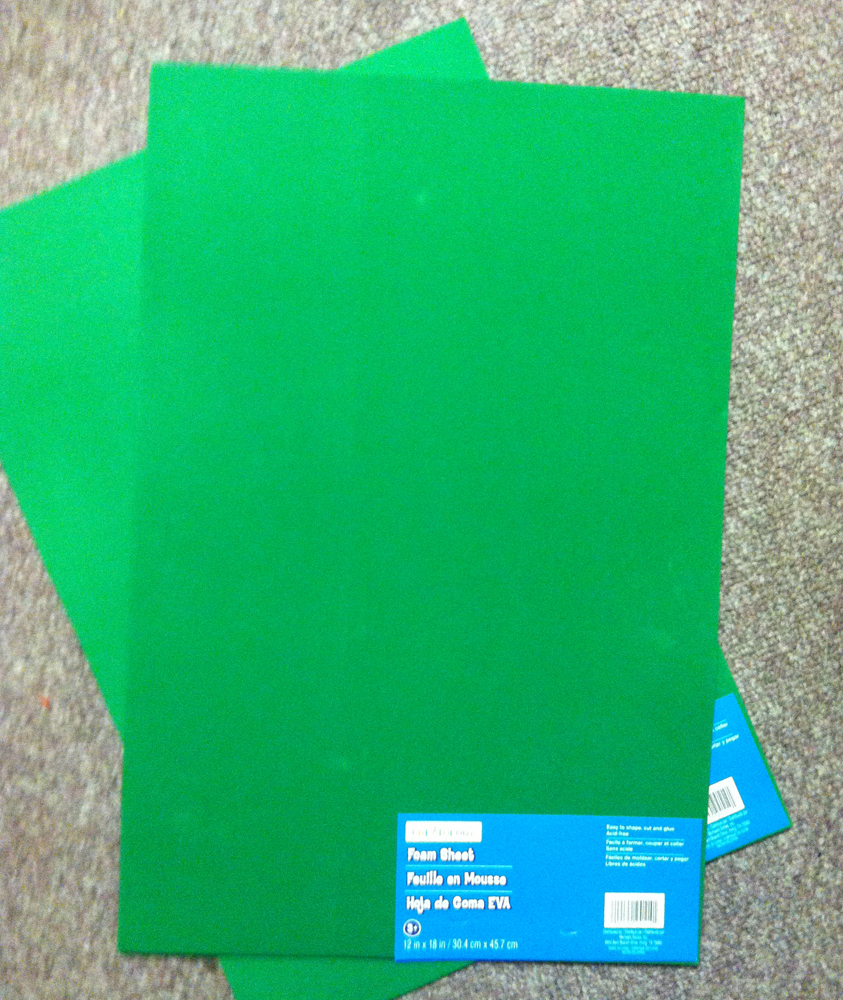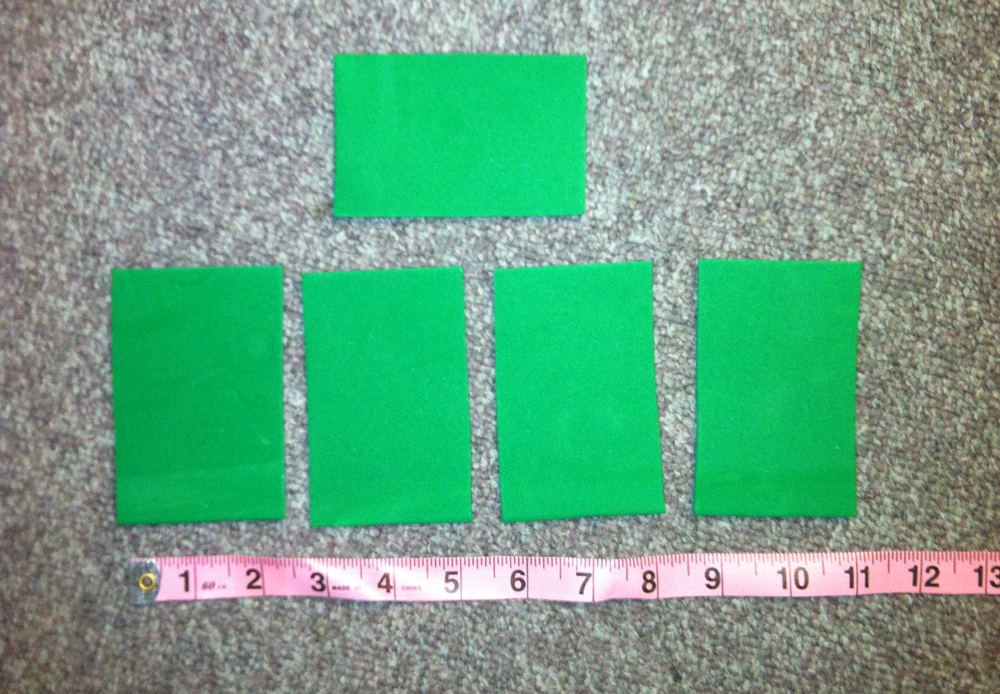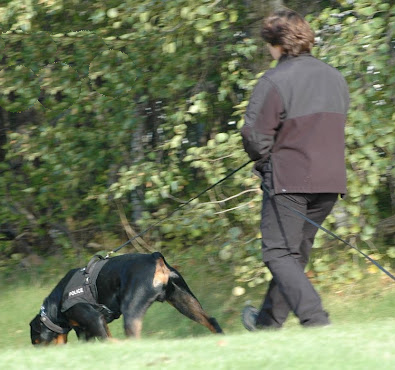This class covers everything the handler needs to know to get organized and get started in tracking. We will discuss topics such as equipment preferences, other equipment needed, how to develop a start routine, tracking schedule, and initial training goals. This class will also cover what the tracker needs to know regarding environmental conditions, scent theory, and how to select tracking fields to shape correct behavior. The dog will be introduced to beginning tracks, with an emphasis on developing an independent tracking dog – how to let the track do the teaching. This program uses targets with food on them and then, as soon as possible, we swap the targets out for food-less articles. So while we do use food, hopefully, something the dog really likes, the goal is for the dog to quickly learn to track between the targets or articles. This class starts with dogs who are brand new to tracking (or ones who are repeating other foundation training), so we start from the very beginning and proceed in a methodical step-by-step manner. With each Gold student, I will review their video and then advise them on how to set up the next track. If the dog is doing well, I usually just suggest the next step. If changes need to be made I try to explain why I am making them. Lectures will be released once a week and each one builds upon the previous one. There is usually a wide enough variety of dogs in the class so that that bronze and silver students can identify at least one dog similar to theirs. Please contact me if you have any additional questions about the format of the class. This class with have a Teaching Assistant (TA) available in the Facebook discussion group to help the Bronze and Silver students! Directions for joining will be posted in the classroom after you register and before the start of the class. Lucy Newton (she/her) has been training dogs and teaching dog training almost all her adult life. She was a search & rescue dog trainer, handler, and instructor and trained numerous personal dogs for wilderness search and rescue, as well as land and water human remains detection. Working with very active wilderness SAR teams, she worked on a large number of missing person cases in both urban and very remote wilderness locations. (Click here for full bio and to view Lucy's upcoming courses)Course Details
Teaching Approach
 Instructor: Lucy Newton
Instructor: Lucy Newton
TR101: Foundation Tracking 1
- Details
- Category: Course Descriptions
Sample Lecture
And here we are at Week Four!
Time is flying by and I am really happy to see that all of the dogs are progressing. As we are observing in the videos of the gold dogs, the speed of progress really depends on the dog. It is a very individual thing and, as we all have been able to observe, it also depends on being able to find ideal conditions for laying the foundation tracks. I would be the first one to say that there is certainly more than one method to train a dog to track. However, I also see and hear quite often from people all the time who are struggling. Most of the time what I observe is that the dog has some idea of what tracking is and sort of heads in the right direction. He may miss turns and then circle back to find the corner. However, he often lacks accuracy and confidence and has not learned to work independently of the handler and the line handling. The dog has not learned that the track is the pathway to reinforcement. So even though we are proceeding slowly at this point and we are being fussy about how close to the track the dog should be, we are really trying to lay a strong foundation. We are not training IPO or Schutzhund dogs, however, we are making sure to create a reward/reinforcement history on the track and we are rewarding the dog for very short sections of correct tracking. It may seem slow and fussy but it is well worth the investment in effort.
As we gradually increase our spacing we are progressing towards creating both a great amount of value for the glove articles as well as shaping the dog to follow the track for a short distance to find the targets/articles. Incidentally, I selected the gloves as a good beginning article because they are cheap, they can be purchased in bulk, and, being brown, they are less visual to the dog. At this stage of training, I also like that they are consistent. They are recognizable as the article/reinforcement. I won’t wait forever to introduce a variety of articles of all shapes and sizes, including TDX or VST articles, but right now I like to give the dog some visual confirmation that he has reached his goal and been successful. The article is the reward so we want him to have a little bit of a "yay! I found it!" reaction when he reaches it. Not puzzlement as to what that weird thing is doing out there on the track and if it is an article. A little bit later we will start offering some variety in the articles but for now, just stick with what you are using.
As we progress we will be increasing the spacing gradually without losing the style that we are currently shaping. Most importantly we want to increase the spacing without allowing the dog to use other cues in order to be successful. This is not to say that the dog still won’t make errors, however, if our foundation is in place (the dog knows that the track is the path to reinforcement) he will learn to self-correct and, as he does so, he gets reinforced by reaching his goal – an article. It is important to be willing to invest the effort into rewarding the articles rather than giving them cursory attention for the sake of the track. Years ago I did some training with a tracking group. If the dog missed an article they would call the dog back, point out the article and make him indicate it. The logic of that did and still does baffle me. What is the point? Other than to send the message to the dog that he need not worry about the articles; his handler has got them covered!? If my dog misses an article I make a mental note to myself to build more reinforcement for the articles. I usually put a small amount of food on the articles, just enough to make the dog stop. I then run up and reward profusely on the article. The food on the article is just enough to give us time to get in front of the article and reward the dog.
As we increase the spacing the dog is forced to figure out a way to get to the next target/article. If we see a lot of error in that process then we know we are progressing too fast and we need to lower the spacing. But a little bit of error and the dog learning how to self-correct is vital to his being able to do longer, complicated tracks with a lot of scent and environmental challenges. Small amounts of errors are what allow the dog to teach himself. He gets off the track a little, notices it on his own, reacquires the track, and is rewarded for it. Our spacing is still close enough together that the dog will quickly be rewarded for self-correction. Here is a short clip of an error in one of Jill's tracks. You can see her quickly get too far to the left of the track, self-correct and reacquire the track, hit a target, and then proceed correctly. Note that this is very different from a dog that is being prevented from going to the left or right of the track by the handler's line handling.
Jill Day 10 - an example of self-correcting
Don't be worried that this process of increasing the spacing is going slow. Once that lightbulb goes off and the dog is not only following the track but also expecting to find targets then we can much more quickly increase the spacing. However, it is worth it to invest some time into the 1 and 2 step spacing.
As we start asking our dogs for small distances of tracking between the articles we need to become more aware of what is going on scent-wise within our track. Scent Theory and Dynamics can be (and is!) an entire class in itself. However, a basic understanding at this point is necessary. As we progress we want to challenge the dog but not overdo it with too many new or difficult variables. The basics of some of these variables are the topic of this week’s lecture. I will cover the variable of track length and track aging in next week's lecture.
What Is Scent?
In order to understand how scent is influenced by the environment, we first need to have a working definition of what scent is. Tracking enthusiasts can and will debate endlessly on what exactly the dog is tracking. Not being a dog, I can only speculate on the clues that they are using in order to follow a track. As we move through the world all of us are continuously giving off our own individual scent. Remember the Peanuts character Pigpen? That is what we all look like, walking around encased by our cloud of (invisible) scent.
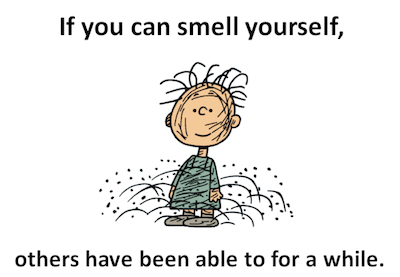
This scent is primarily made up of skin cells and bacteria. As I walk across my yard, surrounded by my cloud of scent, I am shedding thousands of invisible, cornflake-like, “rafts” of scent. As I walk I am also changing my environment. I am crushing grass, scuffing the dirt or pavement, disturbing the ground in some way, etc. The tracking dog is likely using some combination of all of those above factors in order to follow my track and get reinforced.
What types of variables influence scent?
Temperature
From the skin cell perspective, dry arid conditions are going to desiccate all those flaked off skin cells lying around and it will also reduce the bacterial action occurring on them. Both conditions will decrease the amount of odor that is available to the dog. In addition, dry conditions will affect our influence on the environment. Think about walking across your lawn when it is moist and lush vs. if it were dry and arid. Your footfalls will have a much lesser impact on the environment with the latter scenario. This isn’t to say that the dog can’t follow the track but it requires more focus and concentration.
For explanation purposes, I often suggest people think of scent in terms of a color. Picture me walking out my front door and heading across town, spray painting my track behind me. If I took a can of bright red paint with me then you could likely follow my track easily. But what if I went out with a can of gray paint instead? You could still follow it but you would have to be slower and more methodical and it would require more stamina and focus. In order for the dog to follow the “gray track”, he needs to have skills but most importantly he needs to be convinced that if he works hard enough he WILL be successful. He needs to have that foundation in place so that he is always working to get himself back on that track, no matter how faint, or gray it is. His foundation allows him to recognize the pathway to reinforcement and he is motivated because he knows he can be successful following it.
Here are a couple of examples of my dog Steel working portions of some tracks. Steel is now a 9-year-old Rottweiler, I have had him since he was a puppy, he has his CT and also was my police patrol dog prior to my recently taking a full-time K9 training job. In both of these tracks, I have presented him with some relatively complicated tracking situations. Things specifically designed to challenge him both in terms of the terrain but also with the variables that we are discussing here. I refer to these spots in the track as "puzzles". These variables affect the track and contribute to its level of difficulty. These clips are from tracks run on a college campus so there is the added influence of contamination. These are not clips where Steel is perfect but rather places where he is demonstrating a challenge to his current skill set and he has to problem solve.
Steel Puzzle #1 Clip
Steel Puzzle #2 Clip
Humidity
Humidity often seems to go hand and hand with heat; at least for those of us unlucky enough to experience tracking in areas with a significant amount of hot and humid periods throughout the year. Humidity keeps the ground moist and also allows the skin rafts to stay moist. In theory, this should create more scent for the dog. However, there are a few complications to that assumption. The primary one that I have noticed is that during periods of high heat and humidity the dog needs to pant more. In order for dogs to process scent, they need to draw air through their nostrils. If they are panting heavily then less air is crossing the nasal passageways. Heavy panting is obviously counter-productive to good tracking. Acclimation to conditions is a big factor when working in both heat and humidity.
Another, often overlooked, concern about humidity is at the other end of the scent spectrum. Too much scent. This can be just as challenging as not enough scent; especially early on in the training when the dog isn’t sensitive to scent gradients. Think of the hot/cold game many of us played as a child. We were directed towards an unknown location by being told we were getting warmer or colder. For the inexperienced dog, the track is mostly either hot and cold. Right now in the foundation class, we are trying to make sure that is true. But as the dog gains experience he is able to notice greater levels of “warm”. If I have a warm humid day with lush grass and no wind then my skin rafts hang in the air like a cloud after I walk through the area. I also have a big impact on the environment when I walked through that lush grass as well, creating lots of disturbance. The scent of the disturbance also hangs in the air. If we go back to our analogy of scent being a color then the swath of that red line is very wide rather than narrow. The dog must be what I call highly "gradient sensitive" to work the above track. The top track has a lot of scent dispersed to each side. The dog must be very sensitive to differentiate the pink area from the red area. The bottom track is pretty much a narrow line of scent. Much easier for an inexperienced dog.
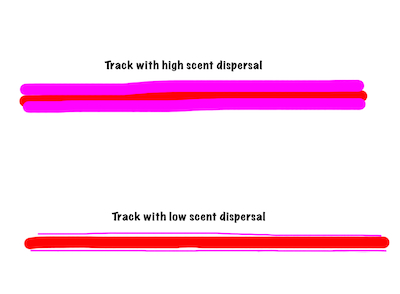
I do not have any good example of a dog working in such a scenario but here is a good example of Steel demonstrating sensitivity to scent gradients. In this track Steel intersects the track perpendicularly. He checks the track and determines which direction it goes. As long as I have been tracking I still am amazed to watch what dogs can do and this is one of the things that impresses me the most. From a genetic standpoint, it makes sense that dogs have this ability, what is the points of backtracking the scent of a rabbit? But it still amazes me that dogs can figure this out!
Wind
The term wind is misleading because we usually think of the wind as being strong enough to move tree branches and blow leaves around. Air currents are a more effective term for our purposes. The air currents are continuously acting upon those skin cells that we leave in our wake. They are also affecting the scent that is given off by the ground disturbance that we create when we walk. Sometimes air currents are very obvious – think of the leaves that spin and eddy in the corner of a building. But airflow is also having subtle actions upon scent all the time. Sometimes it is simple and the dog works through it without us noticing. Other times it is more obvious and we can watch them work through a more complicated problem. Air currents are a big factor in influencing how the dog can track at advanced levels and are one of the main reasons we lay a strong foundation and let the dog develop a solid skillset in problem-solving.
Ground surface
Grass, dirt, mulch, asphalt, blacktop, etc all present different scent pictures to the dog. They also influence the scent that is available to the dog in many ways. The texture of the surface can hold skin rafts or allow them to be dispersed. Short dry grass will allow the skin rafts to be cast over a wider area. It is also more resistant to crushing and will leave less vegetation scent. Different surfaces can also generate heat or block or influence airflow. The important thing to realize about the ground surface is that it will almost always have scent but the dispersal of the scent and its intensity will be affected.
Overview
That is part one of the very basics of scenting theory and the effect of the environment on tracking conditions. It is a topic that can be a little bit dry but it is important to at least have a basic understanding of the topic. For those of you that want to know more, an excellent resource is a book titled “Scent and the Scenting Dog”. It is an older book but still, as far I know, considered the bible of scent theory. Through the FDSA we also offer NW150 Scent Theory and Dynamics.
I have read quite a bit and understand a lot about scent theory and tracking conditions. However, to be honest, most of my knowledge has been gained by watching my dogs. For a dog like Steel, I don’t worry too much about what is going on other than for it to provide me with information. He is experienced, very committed to his track and he tries extremely hard. I just try to stay out of the way and let him work the problem out and continue to build his skills. There is a common saying amongst dog handlers “TRUST YOUR DOG”. That saying annoys me somewhat. Too many times it seems to encourage handlers to blindly follow their dog all over the place. Without the proper foundation in place, I would NEVER allow my dog to work in the manner that I work Steel in the above videos. I wouldn’t handle the dog differently. I just wouldn’t set him up to run such tracks or encounter those conditions before he was ready. A much better saying, in my opinion, is to “TRUST A TRUSTWORTHY DOG”. My job is to lay the foundation that shapes the behavior that affords the dog success. Then I put my dog in situations where he is able to hone his skills and is challenged but not over faced by the conditions. If he can’t solve a particular puzzle due to the conditions described above then I find ways to allow him to develop more skill.
Finally here is a last clip of Steel, just so you can see what a serious worker he is; he is all business when he reaches the end of a track....
Steel Shameless End Zone Dance
This Week's Homework
Since the above lecture was SO long, I have moved the homework portion into its own lecture and will post it in the next couple of days. This is also because different dogs will get to this point in training at different times and that way the handler when they are ready, can go directly to the lecture itself for instructions on how to set-up 45 degree turns.
Prior to adding turns, we want to get the dog working a smooth track at 2 step spacing. We want him not merely finding the targets at each step, but also expecting to find the targets. That is an important distinction. When we change variables later on the dog needs to know what to do in order to get the reward. Any doubt and he will experiment with other clues and then the handler has to try to handle him in a way to avoid reinforcing the incorrect behavior. That can be difficult so we want to keep the error small and manageable. That is why I have held everyone at 1 or 2 steps for a longer time. Once the dog is mastering tracks with two-step spacing we are going to move on and add 45 degree turns to the track.
So let's get started with Week Four!!
Testimonials & Reviews
A sampling of what prior students have said about this course...
Great methodology - clearly communicated. Wish I'd had this class 'way back when I was struggling to learn what tracking was all about. Great foundation class. Rosemary B.
I really enjoyed this course: it got Shine and I off to an excellent start in our tracking career. Lucy is an excellent instructor, and tailors the training to each individual dog, with some creative solutions for dogs that were struggling with tracking using the initial set-up. It seems odd to learn tracking from an online course since a lot of it is about feel and timing from the handler, but it works - videoing using a chest/head-mounted gopro enabled Lucy to see what we were doing from the handler perspective and to see what we were seeing as the dog went down the track and how we were line handling, etc (assuming the camera set-up was correct!). A GoPro (or similar) camera (or an extremely dedicated partner in crime!) is really a must-have to get the most from the course.
It's amazing that you can learn and teach tracking online, but Lucy Newton has proved that you can! I have just completed TR101 as a Gold student, and the feedback was so highly personalized for each student, it was like I had a private teacher for 6 weeks. I am really happy with the way my dog is going, and I love Lucy's method of teaching the dogs what we want when we talk about tracking, it really fits with the science of what I already know about dog training. I can't wait to do more!
I've read several book on how to train tracking, as well as a lot of videos/DVDs, and the method used in this course makes the most sense of ALL the ones I've tried.
Again, Lucy is fantastic. She really gave each and every one of us exactly what we needed exactly when we needed it!
I was very happy to find out about the Fenzi Academy because I live in an area where finding good instructors for dog sports can be difficult, particularly those who use positive methods for training. Lucy Newton is world-class, very helpful and knowledgeable about her subject. She is keenly aware of differences in dogs and their progress and abilities. I would recommend her tracking courses to anyone who wants to teach their dog but cannot find a teacher (or wants a better one) or who finds books on the topic somewhat lacking. Great course. Tracy S
I really enjoyed this course. I found the instructor to be very knowledgeable, helpful and quick to reply. We will definitely be taking more courses. Thank you for everything, Sherri R. and Soter
Great class! Very informative.
I have been excited to start tracking but didn't want to train on my own for fear of messing up my dog. So glad I waited and the class made perfect sense! I was out of town for a large portion of the class so still behind but excited to work through and join in on part 2 (even though I anticipate I'll still be a bit behind).
My dog and I both had a lot of fun in TR101, and the combination of lecture material and Lucy's detailed, personalized instruction at Gold was perfect for a complete tracking newbie!
We have really enjoyed this class and thought everything about it was just perfect - from the lectures to how the video lessons were done, the feedback and the gradual steps. Thanks so much! I’m so happy we have been guided in such a skillful way while trying something completely unfamiliar to us. I feel confident that we have started on the right path and know how to evaluate our progress as we proceed. It is also endlessly fascinating to learn about scent and watch our dogs do what they already know how to do, while we are along to guide and observe the process.
Thank you, Lucy, for sharing your vast knowledge with us! This class will be invaluable for our tracking future and I am looking forward to taking more classes with you!
Great experience with tracking 101, signing up fir the next one!!
This was my first gold class and I was worried about video and posting, but it all worked out after I made a bunch of mistakes. Enjoyed the class and think we made progress, I have useful information to go forward with. Will plan on returning for next level.
I have never had any experience with tracking. I feel that I have a very good strong foundation from taking this class. The instructor made it literally impossible for the students to fail (other than she couldn't magically make their snow melt or their grass grow longer.) I love tracking so much now and it's the happiest days of my weeks. My dog likes it too and I believe that the extended focus on the tracks has improved her focus in other areas of life.
Registration
There are no scheduled sessions for this class at this time. We update our schedule frequently, so please subscribe to our mailing list for notifications.
Available as a prerequisite purchase with lectures only until December 15th.
TR101 Subscriptions
 Bronze |
||
|---|---|---|
| Tuition | $ 65.00 | |
| Enrollment Limits | Unlimited | |
| Access all course lectures and materials | ✔ | ✔ |
Find more details, refund policies and answers to common questions in the Help center.

